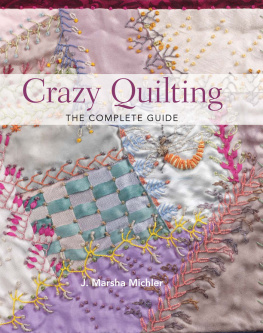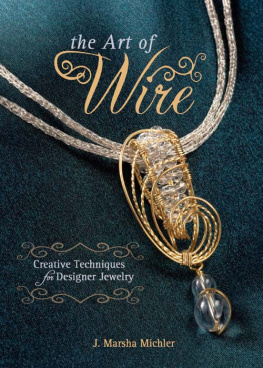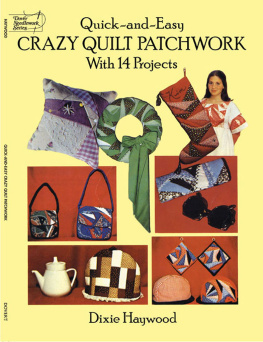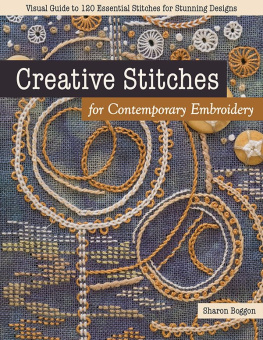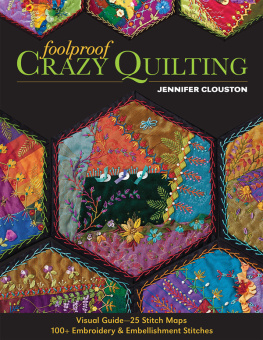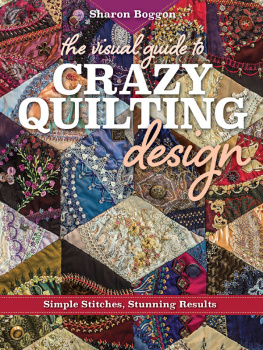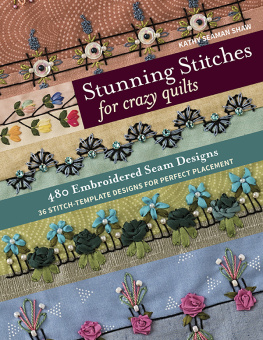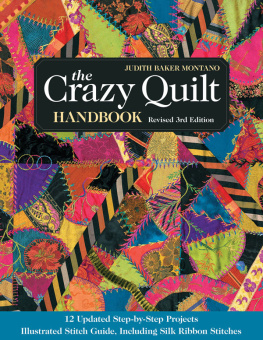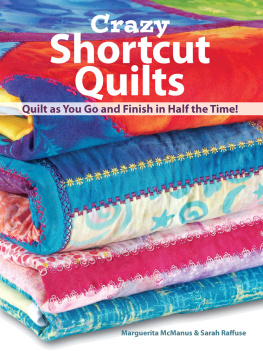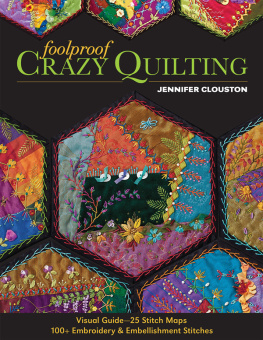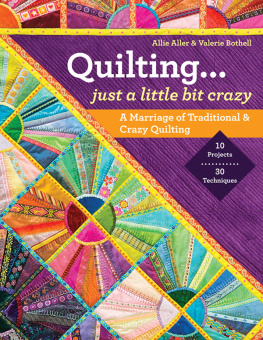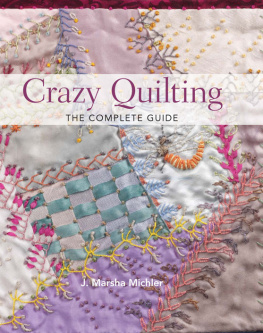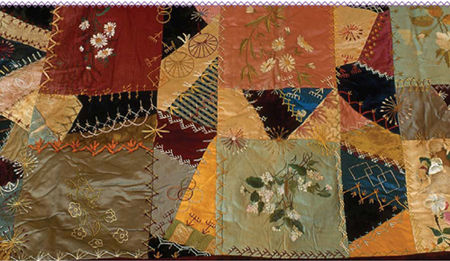First, I'd like to extend my gratitude to all of the wonderful folks at Krause Publications for seeing yet another of my books into reality. It's always a pleasure to work with you! Specifically, my thanks to editor Erica Swanson; book designer Heidi Zastrow; photographer Michael Croatt (www.wisconsinprairie.com); and acquisitions editor Candy Wiza. Many thanks to my suppliers and contributors for all of the beautiful materials that are so fun to use. Your contributions are enrichment to these pages:
Dena Lenham of Kreinik Mfg. Co., Inc.
Jane Garrison of YLI, Inc.
Thanks to Andrea Strassner, curator of the Saco Museum in Saco, Maine, for permissions to publish photos of the beautiful crazy quilts in the museum collection.
Thanks to Cindy, Jen, and Sharon of the Limerick Public Library for showing my work and keeping my books available. Thanks also to Lisa Ruble of $100,000 Quilting Challenge magazine for publishing my article on silk crazy quilting (Issue #2, 2007), to Kimber for inviting me to contribute to CQmag online, and to the students of my Adult Education crazy quilt class.
A very special thanks to my mom for believing in me all of these years, and an extra-special thanks to my husband, Gil, for the sushi and gourmet dinners that have kept this artist sustained.
A Thousand Stitches
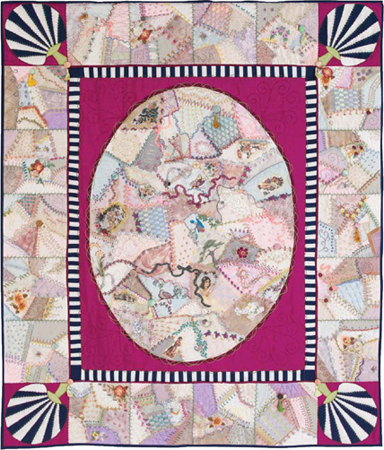
Inspired by the idea of creating a book that hones in on the essentials of crazy quilting, a vast concept that will never be conclusive, I designed this quilt with several main ideas.
Quilt style: The oval center is the whole-quilt, while the border consists of the block style of crazy quilting.
Silk fabrics: A celebratory idea, to revel in the luxury of silks! Patches include hand-dyed silks, woven ribbon patches, fabricated patches, pieced fans, and covered buttons.
Embroidery stitches: Stitching along the patch edges is comprised of approximately 1,000 different stitch combinations and variations. Embroidery threads are pulled from my entire stash and include cottons, silks, and rayons of many types.
Embellishments: Techniques and trimmings are cotton and rayon motifs, cotton laces, ribbon work, silk ribbon embroidery, embroidered motifs, photo transfers, covered buttons, and punchneedle.
Design/Contrast: Crazy quilts can be designed with distinctive areas. Contrastive elements in antique crazies tend to be the patches themselves, but here I differentiated by using contrast to define areas.
A Thousand Stitches
took second place at the Maine Quilts 2006 show.
The finished quilt is approx. 49 wide by 57 long.
Introduction
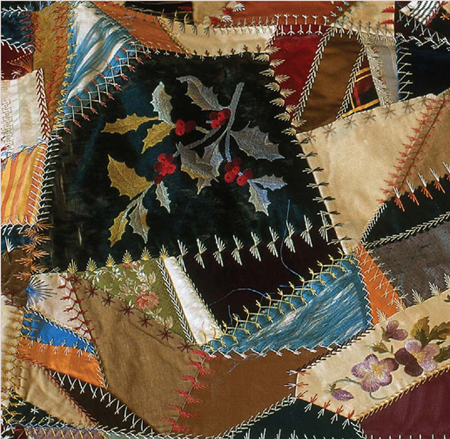
This vintage crazy quilt features beautiful motif embroideries. Detail. Museum Collection, Dyer Library/Saco Museum, Saco, Maine.
The art quilt of the Victorian Age is revived for modern times with an updated, fresh look but with its roots intact. It is still a means of self expression for needle artists. It still has us gawking over fine fabrics and gorgeous threads; still has us searching for what to do with an old piece of ribbon, or how to dye or paint a piece of cotton lace so it blends into a motif. In a way, little has changed in more than one hundred years.
This book is intended as a reference; that is why projects are featured as examples of techniques without instructions. For project instructions, please refer to my other books and those of other authors.
Use this reference to learn some new skills, hone some beloved old ones, and for suggestions and inspiration. Use these ideas to tweak your quilts and crazy projects with colorful dimension and textures. Enjoy!
What is Crazy Quilting?
Crazy quilting is a creative form of quilting in which patches are made in irregular shapes and sizes. In most methods, patching is worked on a foundation fabric, which displaces the traditional quilt batting. A crazy patched piece is oft en treated to embroidery and embellishments and is traditionally tied, not running-stitch quilted.
Choose Your Expertise Level
Beginner: Start with cotton muslin foundation, fabrics that hold a crease and are easy to work with, such as cottons, rayons, and linens. Beginners find size 8 pearl cotton the easiest thread for embroidering.
Intermediate: Experiment with incorporating silks and a greater variety of all fabric types. Try other threads, such as rayons and silks, for embroidery. Dabble with all of the embellishment techniques. Be willing to experiment and expand your horizons.
Advanced: Make an all-silk quilt. Use silk organza fabric for a foundation, hand-dyed silk fabrics, and silk threads for embroidery. Work on refining you techniques in any of the embellishment methods.
The Basics
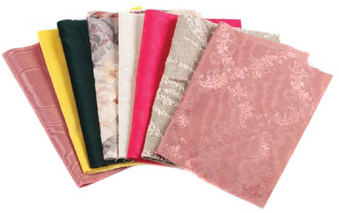
Fabrics with surface textures work well for crazy quilting. Rich texture adds variation to a quilt top or project. Soft prints work nicely, too.
Fabrics
Rich and varied in their characteristics, fabrics are the background for embroidery and embellishments. Natural fibers are easy to work with and offer wonderful textures. Synthetics are available in many interesting finishes as well. Try them all and pick your favorites. Some of the piecing methods require certain types of fabrics, so check with the method before shopping. See the Appendix for more information about fiber types.

